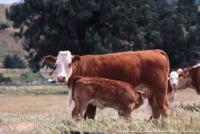Livestock & Oak Rangeland Articles
IMPACTS OF WINTER DROUGHT AND OAK TOXICITY TO LIVESTOCK

There are more than 50 common species of oak trees in California and all contain some levels of the toxic tannins and phenols that can cause problems in cattle. The buds, young leaves, and fresh acorns have the highest level of toxins. There is considerable variation in the concentration of toxins in the plant tissues and is dependent on (1) the species of oak trees, (2) the season of the year, and (3) the climate of the year in question.
Most California beef cattle spend at least part of the year in areas where oak trees abound. The problem with oaks is that they can be toxic to cattle. Disease problems due to ingestion of acorns or oak leaves are not an everyday problem; however, when problems do occur they can be catastrophic. Several years ago, in a few northern California counties, about 2,700 cattle died due to oak toxicity. Why are we concerned this year?
In a normal year, fall rains typically coincide with oak trees shedding their nuts. As the acorns fall, winter grasses begin to grow and quickly camouflage the nuts lying on the ground. In drought years, the lack of green grass makes the acorns easily accessible to foraging animals. In addition the lack of available feed makes the nuts and trees more enticing.
How do the toxins affect the cattle?
The oak toxins (tannins and phenols) cause damage to the gastrointestinal tract (mouth, esophagus, rumen, and intestines) resulting in ulcers, bleeding, and perforation. In some cases the toxins can travel to the kidneys where they cause severe damage resulting in renal failure and death. Younger cattle (less than 400 pounds) are usually more severely affected than older cattle.
What do the affected cattle look like?
Symptoms usually appear shortly after cattle eat 50% or more of their diet as oak (leaves, buds, acorns). Some animals may simply be found dead. A day or two after eating oak leaves or buds, bloody or dark diarrhea may be noticed. Throughout the course of clinical disease, the cattle appear weak, listless, and have no appetite.
What are the most important risk factors that can lead to oak toxicity?
The presence of large numbers of acorns when forage is scarce is one of the main risks. Wind, hail, or snowstorms can cause large numbers of acorns or limbs with leaves and buds to drop so that cattle can gain easy access to these potentially toxic materials. California outbreaks have been worse in the late winter and early spring when oak buds and small leaves are present in large numbers and a wet snowstorm occurs. The wet snow breaks branches and limbs which fall to the ground. The snow also covers the available grass and this leaves the cattle very hungry. This leads to consumption of these very toxic buds and young leaves because it is the only feed available. Likewise, this year with the large acorn crop and dry conditions with very little grass, the consumption of acorns has been very high in some herds.
How do you treat cattle with oak toxicity?
Successful treatment of affected animals usually requires fluid therapy, antibiotics, and supportive care. A veterinarian should be consulted and a treatment protocol set up to increase the odds of success and to provide the most relief for the cattle. The antibiotics help prevent secondary pneumonia and abscessation of the bowel. Fluid therapy will be necessary for many cattle to survive and must be planned with a veterinarian. Ready access to water and good quality grass hay will be very important parts of providing adequate nursing care.
How can oak toxicity be prevented?
Oak toxicity can be prevented by supplementing the cattle with hay or other supplemental feed when forage conditions are poor and acorns are abundant. Likewise, when late snowstorms cover the grass and knock down oak limbs with large amounts of buds and young leaves, be sure to start hay supplementation immediately. DO NOT wait until cattle get sick or die. A delay of only a day or two can easily result in many more deaths and ill cattle. If cattle are in conditions where toxicity is a longer term possibility the use of calcium hydroxide in a supplement can prevent sickness. The addition of 10% calcium hydroxide (hydrated lime) to a supplement will still be palatable to cattle. Then if the cattle will consume about two (2) pounds of this supplement per day it will prevent many cases of oak toxicity. This supplemental calcium hydroxide has to be consumed before exposure to be effective.
Please contact the University of California Cooperative Extension at 754-6477 or http://cecentralsierra.ucanr.edu with your agricultural questions. To speak with a Certified Master Gardener: Calaveras (209) 754-2880, Tuolumne (209) 533-5696, Amador (209) 223-6837, El Dorado (530) 621-5543. Information for this article was collected from the University of California Division of Agriculture and Natural Resources.
